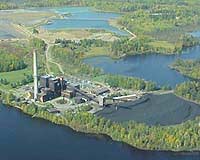Basin Electric Power Cooperative and Powerspan have announced the selection of Powerspan's carbon dioxide (CO2) capture technology for a commercial demonstration at Basin Electric's coal-based electrical generation facility, the Antelope Valley Station located near Beulah, North Dakota. Approximately one million tons of CO2 will be captured annually from the 120 megawatt slipstream project, making this demonstration among the largest in the world.
The captured CO2 will be fed into an existing CO2 compression and pipeline system owned by Basin Electric's wholly owned subsidiary, Dakota Gasification Company.
Today's announcement is the result of the first competitive solicitation process for a CO2 capture demonstration at a coal-based power plant in the U.S. Six companies responded to the request for proposal issued by Basin Electric in June 2007. Powerspan's CO2 capture process was selected as the most promising low cost option for commercial deployment and for its ability to best integrate with Basin Electric's operations.
The project is scheduled to move forward in 2009, subject to successful completion of engineering studies and obtaining of necessary permits and government incentives for early demonstrations of CO2 capture and sequestration. The facility is expected to be operational in 2012.
Powerspan's CO2 capture process, called "ECO2," is a post-combustion, regenerative process, which uses an ammonia-based solution to capture CO2 from the flue gas of a power plant and release it in a form that is ready for further compression, safe transportation, and geological storage.
"Basin Electric has a diverse energy portfolio and runs extremely clean coal-based plants. However, we're ready to move to the next level. That's why we are exploring a project that could lead to commercialization of carbon capture technology for existing coal-based generation facilities," says Ron Harper, Basin Electric CEO and general manager.
"The greatest reductions in CO2 emissions from the power sector can be achieved by developing and proving a technology that can be retrofitted to the hundreds of existing coal-based power plants in the U.S. This is an important first step to achieving that goal."
"Successful commercial demonstration of our post-combustion ECO2 process represents the fastest, and lowest cost route to meaningful CO2 emission reductions from our existing power plant infrastructure," said Powerspan CEO Frank Alix.
"The commercial-scale demonstration at the Antelope Valley Station will provide sufficient information to design, build, and guarantee performance for full-scale ECO2 systems. We are honored to be selected by Basin Electric given their environmental leadership and extensive experience in capturing and sequestering CO2."
Basin Electric's wholly owned subsidiary, Dakota Gasification Company, is the only company in the U.S. that captures CO2 from coal and delivers it for enhanced oil recovery operations. In 2000 Dakota Gasification began delivering carbon dioxide from its coal gasification facility, the Great Plains Synfuels Plant, to oil producers in Saskatchewan, Canada. With over seven years experience in capturing and sequestering CO2, Basin Electric is well prepared to move this demonstration project forward.
The Antelope Valley Station consists of two coal-based electric generating units, each rated at 450 megawatts. The ECO2 commercial demonstration will draw the equivalent of a 120 megawatt slipstream from one of the two units and will be designed to capture 90 percent of the incoming CO2.
The captured CO2 would then be delivered by pipe to the existing compressor station at Dakota Gasification's adjacent Synfuels Plant and injected into Dakota Gasification's 205-mile pipeline system. Approximately one million tons of CO2 will be captured and sequestered annually.
The ECO2 process is a post-combustion CO2 capture process for conventional power plants that is differentiated from other approaches by its simpler capital equipment design and significantly lower energy consumption. The technology is suitable for retrofit to the existing coal-based, electric generating fleet as well as for new coal-based plants.
The CO2 capture takes place after the nitrogen oxides (NOx), sulfur dioxide (SO2), mercury and fine particulate matter are captured. Once the CO2 is captured, the ammonia-based solution is regenerated to release CO2 and ammonia. The ammonia is recovered and sent back to the scrubbing process, and the CO2 is in a form that is ready for geological storage. Ammonia is not consumed in the scrubbing process, and no separate by-product is created.

